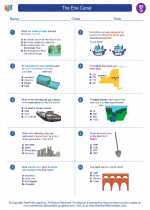The Erie Canal
The Erie Canal is a historic waterway in New York, United States, that played a crucial role in the economic development of the country. It was constructed to create a navigable water route from the Atlantic Ocean to the Great Lakes, connecting the port of New York City to the Midwest. The canal was a major engineering feat of the 19th century and had a profound impact on the growth of trade, industry, and settlement in the United States.
Construction and Impact
The construction of the Erie Canal began in 1817 and was completed in 1825. The canal spanned 363 miles and included 83 locks to overcome changes in elevation. It significantly reduced the cost and time of transporting goods between the East Coast and the interior of the country. This led to a boom in trade, as well as the growth of cities and towns along its route. The canal also facilitated the movement of people to the western frontier, contributing to the expansion of the United States.
Key Facts and Figures
- Construction Period: 1817-1825
- Length: 363 miles
- Number of Locks: 83
- Impact: Lowered transportation costs, facilitated trade, and spurred economic growth
Significance
The Erie Canal was a symbol of American ingenuity and innovation. It set a precedent for future infrastructure projects and was a catalyst for the development of other canals and transportation networks across the country. Its impact on the economy and settlement patterns earned it the nickname "The Mother of Cities" as it contributed to the rise of urban centers in the Midwest.
Study Guide
To better understand the Erie Canal, consider the following study guide questions:
- What were the main purposes of constructing the Erie Canal?
- How did the construction of the Erie Canal impact trade and transportation in the United States?
- What challenges did engineers face in building the canal, and how were they overcome?
- What were the social and economic effects of the Erie Canal on the development of the United States?
- What is the legacy of the Erie Canal, and how does it continue to influence the country today?
By exploring these questions, you can gain a deeper understanding of the historical significance of the Erie Canal and its enduring impact on American history.
[The Erie Canal] Related Worksheets and Study Guides:
.◂Social Studies Worksheets and Study Guides Seventh Grade. The Erie Canal

 Worksheet/Answer key
Worksheet/Answer key
 Worksheet/Answer key
Worksheet/Answer key
 Worksheet/Answer key
Worksheet/Answer key
